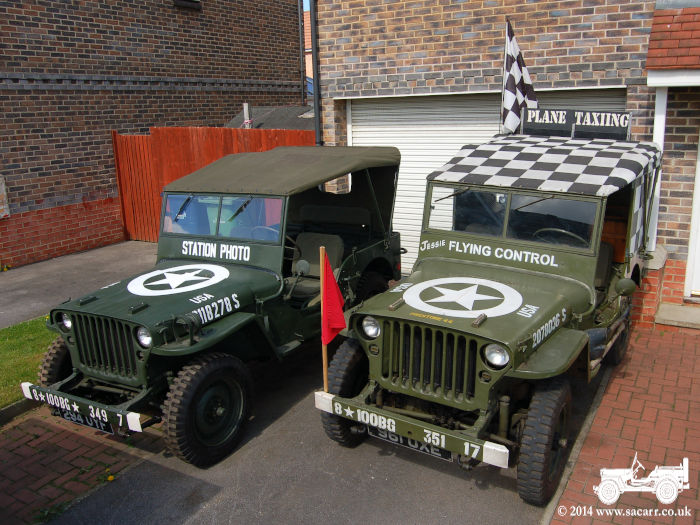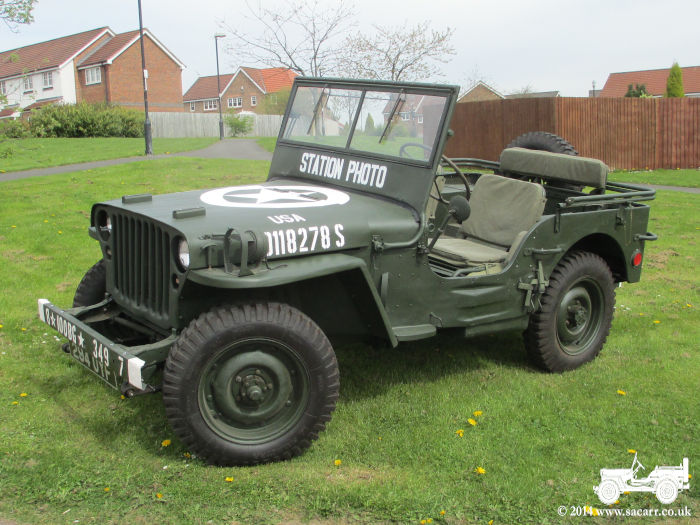 |
 |
| I hadn't found any original markings during the rebuild, despite sanding down through many layers of paint, so chose to base the vehicle on another 100th Bomb Group vehicle - the "Station Photo" Jeep. There were a number of reasons for copying this Jeep. Firstly, I'd found multiple pictures, of the original Station Photo Jeep. Most were black and white, a few were colour and there was also some colour film of the Jeep. Differences in the markings between the pictures showed that it had been repainted at least once in service. These photographs gave me some good reference for the markings. ( pictures reproduced with permission of www.100thbg.com ) |
|
 |
 |
| Secondly, there's a connection to the B-17 "Hang The Expense" which has also been a big part of my life. The crew of "HTE" flew around fourteen different B-17's on their tour. Only two carried the name on the nose. The first B-17, that I modelled in 1/6 scale, was written off in a take off crash as a result of mechanical failure. The other named B-17 crashed at the home base in May 1944. Part way through their tour, the crew were sent for Pathfinder training. They returned to operations flying a radar equipped B-17, to control the bombing of the group by radar when cloud cover hindered bombing. They were now located at a different base.
On the morning of May 19th, 1944, they were to fly with and lead the 100th Bomb Group, their old group. They had difficulty picking up the outer marker lights leading to the active runway and ended up crossing the threshold high. As they crossed the threshold, the Flying Control Officer fired a warning flare which ignited just ahead of the cockpit, temporarily blinding the pilot and co-pilot. |
|
| They touched down without properly being able to see where they were going, but figured they could always be towed back onto the runway if they over ran in the morning darkness. However, they didn't realise they were landing on one of the shorter secondary runways.
A road and a boundary ditch gave them a rude awakening, ripping the landing gear off the B-17 and leaving it fit only for salvage. After dawn, the wreck was photographed before the process of draining the fuel and salvage began. In the background of one of the pictures is the Station photo Jeep. The last reason goes way back to 1998 at the 100th Bomb Group Reunion, when I first driven Steve Bloomer's Jeep. Those were the markings carried by his Jeep. It felt like I'd come full circle. Towards the end of the rebuild, another colour picture turned up showing the back of the original Jeep. It showed it to be a script Ford Jeep. While mine wasn't a script Jeep, I had ended up copying a Ford with a Ford. |
 |
| Stencils were made to match the wartime photos as accurately as possible. This included the large, rearward positioned star with the full circle boarder. The "Station Photo" sign on the screen was carefully scaled from the photo, using photo distort methods, to create a face on view without distortion from perspective. | |
 |
 |
| When
the glass came back, it was siliconed into the screen frame, rather than
use original rubber seals. These seals have a habbit of trapping water
between the rubber and frame, causing corrosion. New Worthings Canvas
seat cushions were purchased and fitted, and the Jeep was close to
completion.
The first engine start was a drawn out process, due to problems getting fuel along 10 feet of fuel line, especially as the fuel pump didn't have a primer. The starter motor was getting too hot, being still a 6 volt unit running on 12 volts. In the end, a new pump was purchased which solved the fuel problem. The engine was very tight, having been rebuilt, and Maurice wanted to see oil pressure using the starter, before the engine was run. However, with the tight engine and 6 volt starter, it was getting too hot via that method, without any sign of oil pressure. |
|
 |
 |
| My
other vehicles don't usually show pressure until the engine fires, and I
figured it was going to be the same with this Jeep. So while Maurice had
wanted to be there for the first run, I ended up doing it on my own,
getting the engine to fire and run for 30 seconds. The oil pressure came
up once running as I suspected, and it was shut down after those 30
seconds until I had confirmed what was done with Maurice. He then gave
me the go ahead for further runs, monitoring temperature and oil
pressure for any problems.
From that point the Jeep was pretty much ready to go. The application was made to the DVLA for a log book and registration, plates were ordered, and the insurance began in mid April when the other vehicles renewal was due. In the mean time, there was nothing much to do but get both Jeeps out for a photo shoot together, the first since the Ford arrived in January 2012. |
|
 |
 |
| So on
April 16th 2014, the Jeep had its first run up and down the street, its
first drive since the day it died on that Texas farm, hoping for rescue.
So after waiting so long, "Hope" is the name given to the
Jeep.
The original data plates gave up enough information regarding the numbers and their positioning, so I was able to stamp the reproduction plates in identical locations. |
|
 |
 |